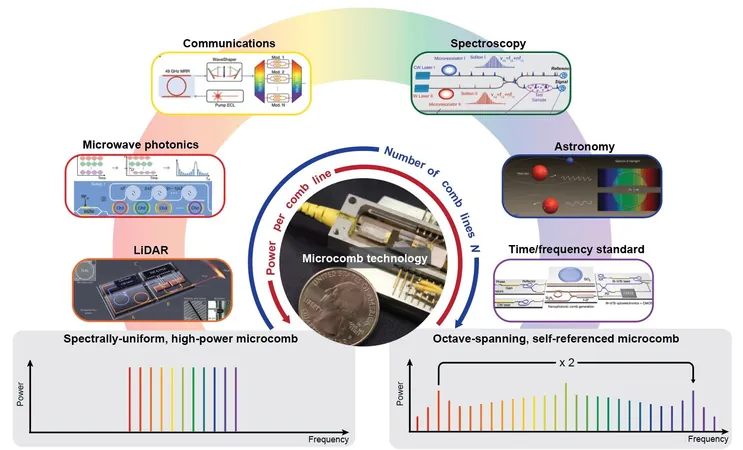
Revolutionizing Precision Measurement: The Rise of Microcombs
2024-10-11
Author: Liam
Introduction
In the world of scientific precision, gone are the days of cumbersome machines dominating the landscape. Welcome to the future—where microcombs, compact yet powerful optical frequency combs, are set to transform how we measure light.
Microcomb Technology
Microcombs utilize advanced microstructures to generate a spectrum of precise colors, much like a rainbow, making them indispensable for a wide range of scientific applications. Recent innovations have significantly boosted their efficiency, allowing these miniature devices to convert a greater amount of light into usable frequency combs than ever before. This remarkable progress, recently highlighted in the journal eLight, signifies a major leap towards making these powerful tools highly accessible.
Efficiency and Portability
Imagine squeezing the capabilities of a large engine into a tiny powerhouse—that's essentially what microcombs accomplish. Their enhanced efficiency opens up new avenues for portable devices that can operate seamlessly outside of conventional laboratory settings, making precision measurement more accessible than ever.
Applications of Microcombs
Microcombs are celebrated not only for their compact size but also for their extensive applications, which include spectroscopy, optical frequency synthesis, astronomical calibration, compact atomic clocks, LiDAR technology, optical communication, and microwave photonics. Their versatility is truly groundbreaking.
Technological Advancements
Central to this evolution is the advancements in ultralow-loss silicon nitride (Si3N4) waveguide technology. This innovation has enabled a shift from experimental prototypes to full-fledged systems that can be mass-produced for real-world use, drastically changing the landscape of optical frequency comb technology.
Design Innovations
A key factor in the efficiency of microcombs is their design. Recent efforts have concentrated on coupled resonators and improved pumping strategies that significantly enhance performance. Among these breakthroughs is the development of flat-top microcombs, which distribute power evenly across their frequency lines—an essential feature for modern communication systems that require consistent signal strength across multiple channels.
Coupled Microresonators
Moreover, researchers have identified coupled microresonators as a cutting-edge solution. This design not only allows for superior energy flow but also helps overcome previous theoretical limitations. By utilizing general critical coupling principles, they have achieved extraordinary efficiency gains.
Alternative Pumping Techniques
Alternative pumping techniques, including pulsed and parametrically-pumped microcombs, are also being explored and show immense promise. These methods optimize the interaction between the pump laser and the soliton waves, further enhancing overall efficiency.
Future Prospects
Scientists remain committed to refining these microcombs, diligently experimenting with various materials and designs to unlock even greater potential. The horizon for these tiny but mighty optical frequency combs is bright, and their continuous evolution is poised to revolutionize countless scientific and technological fields. The age of microcombs is not just a possibility; it is swiftly becoming a remarkable reality. Stay tuned!









 Brasil (PT)
Brasil (PT)
 Canada (EN)
Canada (EN)
 Chile (ES)
Chile (ES)
 España (ES)
España (ES)
 France (FR)
France (FR)
 Hong Kong (EN)
Hong Kong (EN)
 Italia (IT)
Italia (IT)
 日本 (JA)
日本 (JA)
 Magyarország (HU)
Magyarország (HU)
 Norge (NO)
Norge (NO)
 Polska (PL)
Polska (PL)
 Schweiz (DE)
Schweiz (DE)
 Singapore (EN)
Singapore (EN)
 Sverige (SV)
Sverige (SV)
 Suomi (FI)
Suomi (FI)
 Türkiye (TR)
Türkiye (TR)